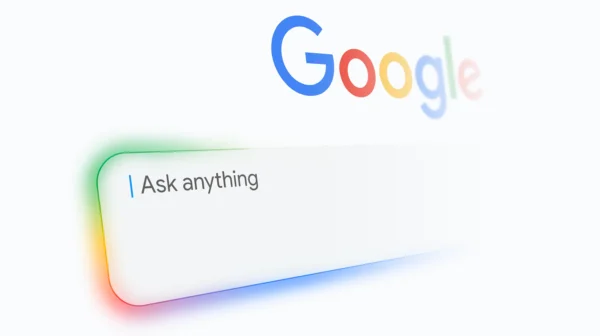AI Mode has launched in the UK
AI Mode is here. Having launched in the US and then India, AI Mode is rolling out to the UK as of this week. You may not see it as an option in the search results yet, but you will soon.
This is no surprise, with Google making a clear shift towards delivering LLM experiences to users – whether this is because it provides a better user experience or because they want to be able to show they’re competitive with the likes of Chat-GPT is probably too early to tell.
AI Overviews have been live in the UK search results for a while now, and having been rolled out further over 2025 we can now see this new feature dominating informational searches, with a steep rise in ‘zero-click’ searches (because Google now answers the search directly in the results).
AI Mode, as it is currently, isn’t a feature that’s live directly within Google’s core search results, and instead is a new type of result that users can choose to access.
It can be accessed next to the search bar on Google’s homepage.
Or through a tab at the top of Google’s search result.
At the moment it’s too early to know what user adoption of AI Mode looks like, even outside of the UK. For the US, where AI Mode has been live to all users since May, adoption rates are somewhere around 2%, meaning that ~2% of searches take place in this new search result format.
The question of ‘how much traffic will brands lose to AI Mode’ depends on how many users move from core search to the new feature. For now, we recommend closely monitoring your organic traffic and looking for areas that are high risk: these will likely be your top of funnel informational content or commercial content.
What is the difference between AI Mode search and Google’s core search?
While Google’s core search results have been changing over recent years (a nod to AI Overviews), they’re still heavily link-centric: there are ‘10 blue links’ surrounded by additional search features, including People Also Ask, product grids, images and more.
AI Mode, on the other hand, is a clear step away from that experience. Giving users a typical LLM response, AI Mode is designed for conversational search, similar to the results given by other LLMs including Chat-GPT and Perplexity. As AI Mode is powered by Google’s Gemini, this is no surprise.
One clear difference between AI Mode and core search, which you’ll see below, is the lack of referring links to websites directly in the text responses. This is the same issue that we’ve seen with AI Overviews, and (we suspect) a large reason why zero click searches are on the rise. Google does link out heavily in AI Mode, but it’s cluttered, distracting and messy. Almost all of the links are contained within the product sidebar (for anything product related) and little to no links are in the text response. For purely informational searches, the linking looks similar to AI Overviews, with cited sources being linked outside of the text response.
In fact, AI Mode tends to link to other Google properties over external websites. Including linking to a brand’s Google Business Profile rather than to their website. While this is a poor user experience, this will hopefully improve over time.
So, what does an AI Mode search look like?
We searched ‘what are the best running trainers for long distance trail running’.
As we can see here, Google’s trying to provide a hugely comprehensive answer, covering multiple possible user intents.
Let’s break this down and look at what Google is giving us:
First, Google shows us how it’s approaching this search. It’s running 6 concurrent searches (this is Google’s query fan out process – more on this here), looking at 141 sites and reviewing Google’s shopping graph. It then takes all of that information and summarises it into the result we see above.
Then, on the right of the results we can see the sources that Google is citing for its product recommendations. For this search, Google is leaning on product review articles to understand which products to recommend.
Next, if we click on one of the products recommended, we can see how Google is leveraging their shopping graph within their answer. Google is listing available retailers who stock the ‘Hoka Speedgoat 5’ and displays merchant centre information (price, delivery, offers, reviews) for each retailer.
Moving further down the product sidebar we can see aggregated product reviews across multiple retailers.
Then, Google is serving product review videos.
Moving out of the product sidebar and further down Google’s response to our search, we can see specific product listings, in the same format as we see for Google’s popular products in core search. Again, this relies on having an optimised product feed.
And lastly, Google’s providing us with additional information to consider when selecting the right pair of trainers.
As you can see, there’s a lot here. There’s no doubt that this is a comprehensive answer, and you could argue that this user experience is as good (or better) than I would’ve had in Google’s core search for this query.
Google’s working hard to satisfy as many user intents as possible, from giving product review articles, product review videos, aggregating reviews and showing retailers to buy from. This gives the user a huge amount of information in one result, and over time Google may evolve this further as it understands what users want to see for each type of query.
What do brands need to focus on to appear in Google’s AI Mode?
AI Mode is in its infancy, and over the next 12 months we’re sure that we’ll come to learn a lot more about what brands can do to actively target AI Mode visibility. But for now, we recommend that you focus on the same areas that you have done pre-AI Mode.
That means that if you’re an ecommerce brand (for example) then you need to have an optimised product feed to appear in AI Mode’s product listings, create helpful content that Google will want to serve to users (across core search and AI Mode!). Focus on building positive brand and product associations online by gathering positive reviews, monitor brand feedback, encourage & engage in community discussions.
Importantly, as a final point (and to reiterate what was said earlier in this article), it’s likely that this is going to reduce clicks to a lot of websites (if adoption rates increase above 2%-5%). These are also personalised results, which means that the idea of rank tracking becomes obsolete in AI Mode. While some tools are already allowing you to scrape AI Mode responses and measure visibility, this is only a rough measure at best.
Don’t forget that the basics of SEO are still as important as ever, but brands have to be prepared to rethink attribution and how performance is measured if we continue to move into the world of AI search.



